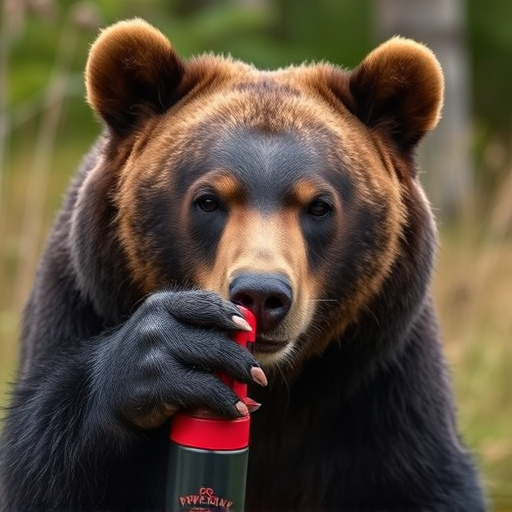Bear spray is a valuable tool for personal protection against bears in wilderness areas but its use is heavily regulated. It's prohibited in urban areas, national parks, and wildlife reserves due to safety concerns and environmental impact. Local regulations vary widely regarding where bear spray is allowed or banned, with specific rules on permits, quantities, and storage. Understanding these restrictions, especially "where is bear spray prohibited," is crucial for responsible outdoor adventures that prioritize both visitor safety and ecological preservation. Alternative safety measures like noise makers, proper waste management, and food storage are encouraged in areas where bear spray is banned.
Bear spray, a popular wilderness protection device, offers a quick and effective deterrent against aggressive bears. However, understanding its usage guidelines, legal restrictions, and alternatives is crucial for responsible outdoor enthusiasts. This article explores where bear spray is prohibited in national parks, state-specific regulations, and safe alternatives, empowering adventurers to navigate the wild with confidence and respect for nature’s rules.
- Understanding Bear Spray Usage Guidelines
- Legal Restrictions on Bear Spray in National Parks
- When and Where Can You Legally Carry Bear Spray?
- States Prohibiting Bear Spray: A Comprehensive List
- Exploring Alternatives to Bear Spray for Wilderness Safety
Understanding Bear Spray Usage Guidelines
Bear spray is a powerful tool for personal protection against bears in wilderness areas, but its usage comes with guidelines and restrictions. It’s crucial to understand where and when it’s permitted. Bear spray is generally prohibited in urban or densely populated areas due to safety concerns and potential misuse. National parks and wildlife reserves often have specific rules regarding bear spray, focusing on minimizing disturbance to wildlife habitats and ensuring visitor safety.
Before considering bear spray as a protection measure, it’s essential to review local regulations. Some regions may require permits or have restrictions on the type, quantity, and storage of bear spray. Adhering to these guidelines ensures responsible usage, contributing to the preservation of wild environments and the well-being of both visitors and wildlife.
Legal Restrictions on Bear Spray in National Parks
In many national parks and protected areas, the use of bear spray is subject to strict legal restrictions. While it’s a popular self-defense measure for hikers and campers encountering bears, certain regulations prohibit its carrying or usage within park boundaries. These rules are in place due to concerns about wildlife safety, preserving natural habitats, and minimizing potential risks to other visitors.
The restrictions vary across different parks, but generally, bear spray is prohibited in areas where wildlife is most sensitive or in regions with specific ecological importance. This means that during peak tourism seasons or in environmentally fragile zones, folks may be required to leave their bear spray behind. It’s crucial for outdoor enthusiasts to check the specific rules of the park they plan to visit and understand where it is and isn’t allowed before heading into the wilderness.
When and Where Can You Legally Carry Bear Spray?
Bear spray is a powerful tool for personal protection in areas where bears are present, but its legal carriage comes with specific guidelines and restrictions. In many regions, carrying bear spray is permitted during outdoor activities like hiking, camping, or hunting in bear country. However, certain locations have strict regulations regarding its use and storage.
It’s crucial to understand that some parks, wilderness areas, and residential neighborhoods may prohibit the carry of bear spray for safety reasons and to protect wildlife. Always check with local authorities or park rangers before heading into the wild. Knowing where bear spray is permitted and prohibited ensures you’re prepared without putting yourself or others at risk.
States Prohibiting Bear Spray: A Comprehensive List
In some states, carrying bear spray is prohibited in specific areas or entirely, making it crucial for wilderness enthusiasts to check local regulations before heading out. Several factors influence these restrictions, including diverse ecological systems and wildlife management strategies. For instance, California, known for its vibrant biodiversity, has strict rules regarding bear spray possession, aiming to protect both humans and wild bears. Similarly, in states like Washington and Colorado, certain national parks and wilderness regions have banned bear spray to maintain the natural balance and minimize potential harm to local ecosystems.
A comprehensive list of states with such prohibitions includes California, Oregon, Washington, Alaska, Wyoming, Montana, Idaho, Utah, and parts of Colorado. These jurisdictions often encourage alternative safety measures, such as making noise while hiking or using bear-resistant containers for food storage. Understanding these restrictions is essential for responsible outdoor exploration to ensure both personal safety and respect for the natural environment.
Exploring Alternatives to Bear Spray for Wilderness Safety
In many wilderness areas, bear spray is not just a recommended safety measure but a requirement. However, there are instances where its use is prohibited due to environmental concerns or specific regional regulations. This raises the question: what alternatives exist for those seeking protection from bears in these restricted zones?
One approach is adopting non-lethal deterrents like noise makers or bright lights designed to startle bears without causing harm. These methods are especially useful in areas where bears have become accustomed to human presence and may be less responsive to bear spray. Additionally, proper waste management, food storage techniques, and awareness campaigns can significantly reduce conflict potential between humans and bears, offering a holistic approach to wilderness safety that goes beyond bear spray.
Bear spray has proven to be an effective tool for personal protection against bears in wilderness areas. However, it’s essential to understand that its usage is regulated and certain locations have specific restrictions on carrying bear spray, as outlined in this article. When planning outdoor activities in national parks or regions known for bear populations, it’s crucial to check local laws regarding bear spray possession. Moreover, while bear spray offers a valuable layer of protection, exploring alternatives like improved hiking practices and noise-making devices can also enhance overall wilderness safety. Remember that knowledge and preparation are key when venturing into bear country.
